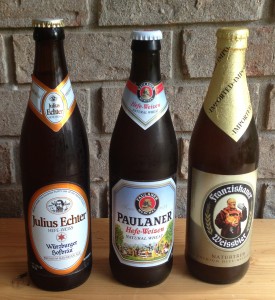This is the third part in a series on German wheat beers. The first part was posted September 3rd.
German hefe-weizens are made from wheat malt and barley malt. A beer must have at least 50% wheat malt to be called a hefe-weizen and a 70:30 wheat to barley ratio is the classic Munich-style blend. Hefe-weizens are normally 11–13 °Plato (OG 1.044–1.052), with some examples being slightly higher.
Mashing the grains for a German wheat beer differs in two respects from most “normal” ale mashes. First, your wheat malt is large, naked (huskless) and sticky (contains more gluten), compared to barley malts. These differences can cause problems when crushing and when lautering. Secondly, adding a rest — called a ferulic acid rest — to you mash program can influence the yeast-derived character in your beer. (Specifically, the clove aspect of the beer’s aroma will be enhanced.)
Wheat Malt in the Brewhouse
The first set of considerations can be dealt with fairly easily. Wheat malt is harder than barley and the kernels are larger. However, if you mill your wheat separately — and try some small test runs first — you should be able to find a mill gap setting that produces a nice crush. Remember, because of the added proteins (including gluten) — and more importantly the lack of husk — wheat can be a problem to lauter, so don’t crush it into dust. I find that, if the distribution of the sizes of the pieces of crushed wheat malt looks to be in the same ballpark as my barley malt, everything will be fine. (In other words, I don’t try to “overcrush” or “undercrush” wheat malt; I simply adjust my mill to get crush results similar to the barley malt.)
Also, remember that although mashes with lots of wheat may be hard to lauter, it is not a guarantee that they will be. If you perform a mash out and collect your wort at a reasonable speed, everything will likely be fine. Performing a mash out helps because it lowers the viscosity of the wort, which is always higher in wheat beers. The dreaded “stuck mash” from a wheat beer grist isn’t quite an urban legend, but lots of homebrewed wheat beers get made without any problem. (And, if it’s your first time and you’re worried about it, stir some rice hulls into your mash.)
The Mash
In a wheat beer, the yeast produce a variety of byproducts that give it its unique aroma. One of the molecules is 4-vinyl-guaiacol (4VG), which lends beer a clove-like aroma. In the biochemical pathway leading to 4VG, the immediate precursor is a molecule called ferulic acid. If a mash contains a rest around 109–113 °F (43–45 °C), ferulic acid — which is usually bound to other molecules (pentosans) in the malt, is released in relatively large quantities. This ferulic acid can later give rise (via decarboxylation) to 4VG during fermentation. So, if you add a ferulic acid rest to your mash program, you’ve primed your wort to contain more of the precursor to 4VG.
The ferulic acid works best at a mash pH of 5.7–5.8, higher than you would normally want your mash pH to be (5.2–5.6). If you need to acidify your mash to get into the 5.2–5.6 range, you might want to wait and do it after the ferulic acid rest.
A ferulic acid rest is not the only — or even the primary — way to manipulate the levels of 4VG in your beer. You can skip it altogether and compensate for this when choosing your yeast and fermentation temperatures. However, it is one way to kick up the level of clove in your beer, if desired. (Also keep in mind that 4VG isn’t the only molecule involved in German wheat beer aroma, something I’ll discuss more thoroughly when I cover fermentation.)
If you can heat your mash tun, the simplest way to add a ferulic acid rest is to mash in, at your normal liquor-to-grist ratio, at 109–113 °F (43–45 °C) and hold it there for about 10 minutes, then heat the mash to ramp up your saccharification temperature. You can also do this in your kettle, then scoop your mash into your lauter tun. You could also do a step infusion mash in which you rest briefly (15–30 minutes) in what used to be called the protein rest range (around 122 °F/50 °C) before ramping up to saccharification temperature.
The traditional mash for a hefe-weizen would be either a single or double decoction mash. (See the recipes, which I’ll post later, for examples of decoction mashes for these beers.)
As I mentioned, if you are an extract brewer, you should perform a partial mash to supplement the wheat malt extract in your recipe. If you’d like, you can add a ferulic acid rest to your partial mash (and I’ll show one way to do that when I post the example recipes).
And finally, of course, you can skip the ferulic acid rest altogether. It augments the levels of ferulic acid in your wort, but some ferulic acid would be present simply from taking a wheat beer grist and performing a single infusion mash.
The next installment in this series deals with boiling and fermentation.
If you enjoy Beer & Wine Journal, please consider supporting us by purchasing my book — “Home Brew Recipe Bible,” by Chris Colby (2016, Page Street Publishing). It is available from Amazon and Barnes & Noble. You can also find the nearest independent bookstore that sells it on Indiebound.


Wheat malt actually contains less ferulic acid than barley. So if you want to increase ferulic acid, consider reducing the amount of wheat in the beer and use more barley.